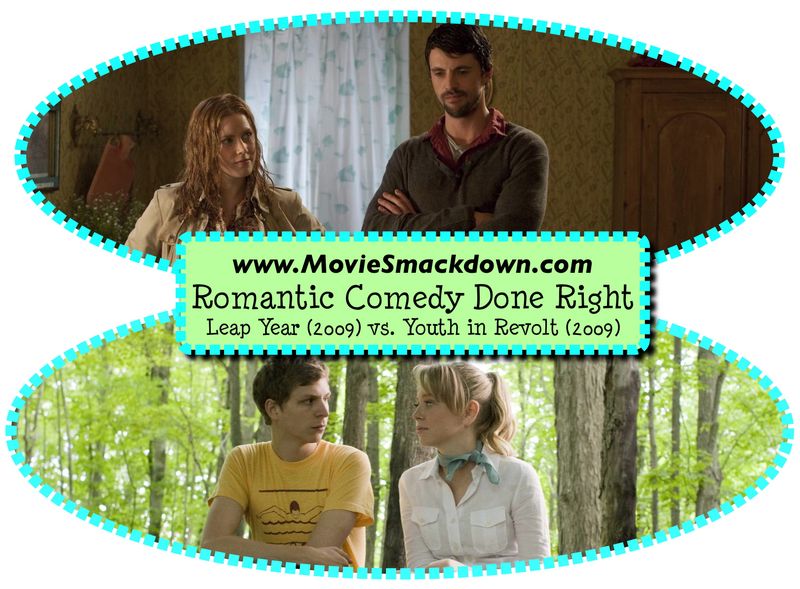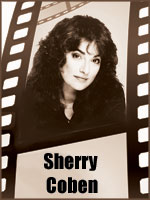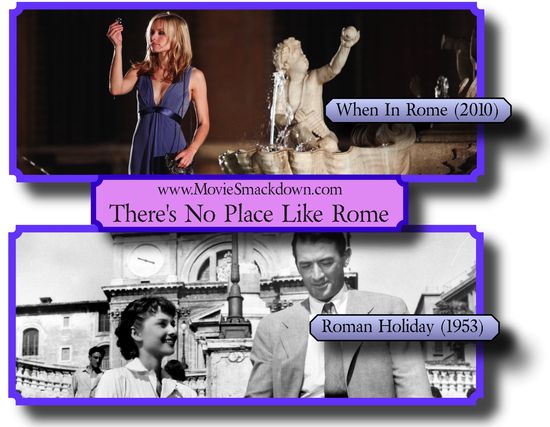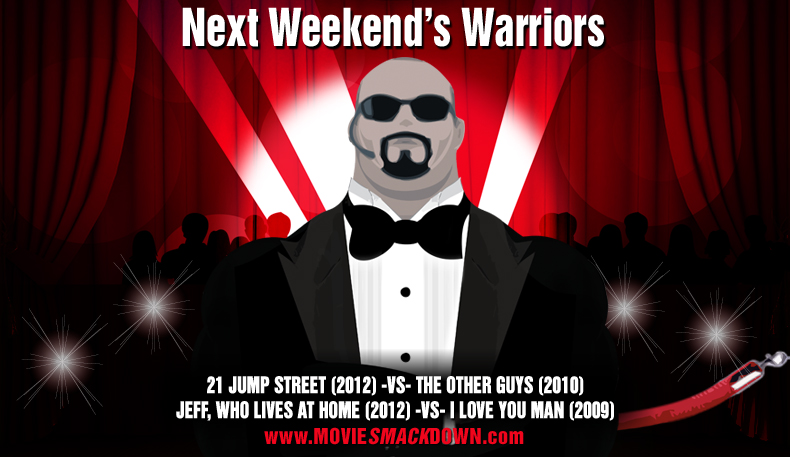
 The Smackdown
The Smackdown
Cookie cutter romantic comedy satisfies a too-easily edified audience. No matter how formulaic and tepid the sausage, the factories grind out more product to feed the gaping maw; indie films usually attract a more marginal fringe-ier crew, on the hunt for the original, the untold (or even oft-told) story told in fresh new ways. Pitting a humble little indie versus a major studio wide release makes for an inherently unfair fight and one with a foregone conclusion at the box office, but ticket sales won’t sway this Smackdown. As “Leap Year†bounds onto virtually every available screen and Quirky Indie-That-Could “Youth In Revolt†limps onto a fraction of that number, ask yourself: Is bigger necessarily better? Does conventional beat quirky? And why am I suddenly possessed with Carrie Bradshaw syndrome?
[singlepic id=236 w=320 h=240 float=right]
In This Corner
“Leap Year†(2009) succeeds beyond my wildest expectations; while perhaps falling short as classic romantic comedy, it ranks right up there among the most beautiful and enticing travelogues ever filmed. Ireland has never looked lovelier, and the two attractive leads do nothing untoward to spoil the view. Matthew Goode makes a scruffy object of conflicted desire, and Amy Adams’ luminous baby blues light up the screen. The script offers some surprises in store for those who’ve never seen a movie before. (The execrable and ubiquitous trailer omitted no plot turn or visual gag and succeeded in thoroughly ruining the moviegoing experience for audiences that frequent theaters.)
[singlepic id=258 w=320 h=240 float=right]
In That Corner. Indie darling Michael Cera heads a cast of other low-key funny folks in this creatively told, utterly unpredictable coming of age story. Such dependable stalwarts as Fred Willard, Steve Buscemi, Zach Galifianakis, M. Emmet Walsh, Jean Smart, Ray Liotta, Mary Kay Place (so grievously under-utilized in the recent “It’s Complicatedâ€) and Justin Long populate the very deep bench and make the utmost of remarkably offbeat material. The terrific and pitch perfect Adhir Kalyan does everything but steal the film from right under their veteran noses. Relative newcomer Portia Doubleday makes a worthy love object, smart and complex, well-written and underplayed.
The Scorecard
“Youth In Revolt†screenwriter Gustin Nash delivers a deft adaptation of C. D. Payne’s novel, featuring richly diverse characters and a plot that ambles and veers in surprising twists and turns. It’s gratifying to see movie high schoolers not dumbed down or tarted up; bookish and writerly and possessed of raging libidos nonetheless, these idiosyncratic teens are rare as hen’s teeth. I remember a conversation I had a long time ago with someone older than I was then (younger than I am now) who referred to my romantic circumstance at the time as “puppy love.†No, I argued passionately. This was “dog love.†“Youth In Revolt†carried me back and reminded me how that first love feels — how real, how important, how central, how life-altering. That gravity is no joke, and this comedy never slights that reality. “Youth In Revolt†is a serious youth comedy.
Director Miguel Arteta serves the material with a sure hand, peppering his dry confection with unexpected snippets of animation sprinkled throughout where bigger budgets and smaller imaginations might feature stale montages. One wishes Arteta had spurred Michael Cera to stretch his chops a bit further in playing dangerous alter ego Francois Dillinger; for me, a little of Cera’s perpetually light-voiced, stalled adolescent act goes a very long way, and a huge opportunity was missed.
Big, shiny movie stars can’t disguise a hash of warmed-over ideas, and all the performing energy and charisma in the world can’t stifle the creakiness of recycled conventions. Predictable stale, by-the- umbers rom-com road tripping rituals addle “Leap Year.†Amy Adams commits throroughly to her character; her considerable charms abound, and her subtle talent fifts the hackneyed material; we believe everything but her romantic confusion. Matthew Goode hovers a bit above the rom-com fray somehow, a wary visitor, an awkward guest at the party, and earns our affection for that very reticence. Adam Scott plays his usual role — he’s the guy who will NEVER EVER get the girl, this one a cardiologist. Get it? He’s a heart doctor! With no heart!
Every American romantic comedy leading lady gets her comeuppance along with her ring. The goal is almost always marriage for these otherwise perfectly functioning and intelligent women, and to earn the prize of her beloved’s affection and troth, she must be reduced to a falling-down imbecile. I struggled mightily to think of a female love object in American movie history who avoided this weird rite of romantic passage. Since Katharine Hepburn and Rosalind Russell first hid their considerably bright lights the better to woo their beaus, the die has been cast. Amy Adams plays Anna from Boston, a successful career woman, a controlling and controlled adult. She’s going to be face down in a pile of mud in a matter of minutes. It’s fate. As soon as she boards an airplane for Ireland, with a daffy plan to propose to her completely undeserving, unworthy, Creepy Cardiologist boyfriend; the movie math is more than clear. He’s a five, and she’s an easy eight even soaked with rain and caked with mud. We never want to see them together, not even for a movie moment. They’ve got no chemistry. We know that the person she initially dislikes, the only young man  (attractive or otherwise) in Ireland as it happens, will be The One. She’s never been to the movies, or she’d know too. The more of a mess she makes, the more he adores her. The more vulnerability and mocking disinterest and machismo he shows, the more she adores him. Sigh. Been there. Plenty. But only at the movies. Every movie.
Rom-Com Conventions: A Partial List/Field Guide For The Connoisseur
Here follows a partial list of those very conventions so familiar as to seem moot. (When an audience member laughs at any of these rom-com moments, I am stunned and amazed. I’m jealous that they have such unspoiled palates, such capacity for pure enjoyment. Then I wonder how such innocents managed to make it to the theater unscathed and how they’ll ever find their way home.)
Expensively dressed women in ridiculously high heeled shoes fall endlessly (and joylessly) into mud resulting in an ever-decreasing comedy spiral.
Does every movie working woman have to wear six hundred dollar shoes to walk in the wilderness? Amy Adams tromps through rain, mud, hail, and poop in towering heels, following in the footsteps of Sandra Bullock (“The Propositionâ€) and Renee Zelwegger (“New In Townâ€) and myriads of other footwear challenged movie stars. Their legs do look great…
Countless perfect coifs drown in ubiquitous sudden downpours. Thank God there are crackerjack hairdressers around to fix things for the next scenes.
Adversaries share an awkward kiss and/or bed for reasons that strain credulity only to discover that they are attracted mightily to the (yawn) prickly difficult person they initially disliked.
Frustratingly glacial discoveries dawn as plethoras of protagonists discover that their unsuitable mates have hearts of stone.
Locals are possessed of innate and infallible wisdom – all strangers see through the quibbling to the love that’s already there waiting for the lovers to discover — their extraordinary wisdom topped only by the ludicrously offensive and extreme stereotypes they are forced to play. (Paging Irish Anti- efamation League. For other recent and flagrant stereotypes: “Mamma Mia!†and “My Life In Ruins.â€Â Personal revelations clutter the rom-com landscape – over-simplified explanations excuse every personality flaw or tic and all is forgiven/forgotten. Why, it’s just like real life.
The interchangeably generic best friend at home (either gay male or less attractive female) whose sole raison d’être is the romantic life of the protagonist lives only to deliver exposition and support. These friends routinely disappear for huge chunks of time as friendship is unnecessary and secondary to romance. For sole exception to rule, see: “Sex And The City†where romance provides mere conversational fodder for primary goal, friendship. Note: All male-driven rom-com works that way. See: Judd Apatow.
Oh, and lest we forget: the utterly unconvincing back-and-forth false beat of an unhappy ending. Gee. What a surprise. We never guessed. Exception: “Pretty in Pink.†Everyone agrees Ducky should’ve gotten the girl.
The Decision
I love romantic comedy. It’s the genre that most frequently disappoints, but I keep heading back to the multiplex for more, expecting movie magic and usually getting served reheated leftovers. Oh sure, he hits me when he drinks, but he can change. While “Leap Year†isn’t a total disaster, I am just so plain grateful to go to the movies and not get out ahead of things that I’m going with “Youth In Revolt.†Chalk it up to middle age in revolt.




Amazing review. I agree with everything you’ve said here. I have to say my favorite “frustratingly glacial discovery” of the unsuitability of the heroine’s fiance is in “Made of Honor.” The script offers some surprises in store for those who’ve never seen a movie before.
We were all in a Lake Tahoe rental home last night and it was the one DVD nobody had seen (Youth in Revolt). Every one of us was surprised and delighted. We howled at the cut from “Solidarity” to Fred Willard driving half-naked. Good decision.
Loved the abusive relationship romcom metaphor in the final paragraph. Another hilarious review. Can’t wait to see Youth and Revolt!
Insightful, and clever, as usual.
This was my favorite quote:
“Every American romantic comedy leading lady gets her comeuppance along with her ring. The goal is almost always marriage for these otherwise perfectly functioning and intelligent women, and to earn the prize of her beloved’s affection and troth, she must be reduced to a falling-down imbecile. ”
You’re amazing!
“The script offers some surprises in store for those who’ve never seen a movie before.”
Classic! So true! I agree with everything you’ve said here. And the list of romcom conventions is very insightful, too. Though I have to say my favorite “[f]rustratingly glacial discovery” of the unsuitability of the heroine’s fiance is in “Made of Honor.” Her realization comes after her fiance won’t let her have a bite of his cake. And of course, whenever anyone asks, “So, what is it that you love about [name]?”, their answer is always, “Umm…” or “He’s… dependable… and… makes a steady income” or just a close-up of an obviously conflicted face and then a cut. Is it really that hard to write convincing romance, even convincing *bad* romance? I know plenty of people who’ve been in relationships with partners who, if life were a movie, would fall into the Adam Scott category, but I at least understand why they’re together. And more importantly, they do.